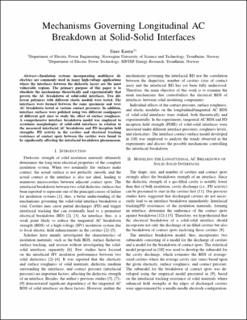| dc.contributor.author | Kantar, Emre | |
| dc.date.accessioned | 2021-10-22T09:00:39Z | |
| dc.date.available | 2021-10-22T09:00:39Z | |
| dc.date.created | 2021-05-31T14:56:15Z | |
| dc.date.issued | 2021 | |
| dc.identifier.isbn | 978-1-7281-9572-8 | |
| dc.identifier.uri | https://hdl.handle.net/11250/2824940 | |
| dc.description.abstract | Insulation systems incorporating multilayer dielectrics are commonly used in many high-voltage applications where the interfaces between the dielectric layers are the most vulnerable regions. The primary purpose of this paper is to elucidate the mechanisms theoretically and experimentally that govern the AC breakdown of solid-solid interfaces. Two different polymers with different elastic moduli were tested. The interfaces were formed between the same specimens and were AC breakdown tested at various contact pressures. In addition, interface surfaces were polished using two different sandpapers of different grit sizes to study the effect of surface roughness. A comprehensive interface breakdown model was employed to scrutinize morphologies of solid-solid interfaces in relation to the measured interfacial AC breakdown and PD inception field strengths. PD activity in the cavities and electrical tracking resistance of contact spots between the cavities were found to be significantly affecting the interfacial breakdown phenomenon. | en_US |
| dc.language.iso | eng | en_US |
| dc.publisher | Institute of Electrical and Electronics Engineers (IEEE) | en_US |
| dc.relation.ispartof | 2020 IEEE Conference on Electrical Insulation and Dielectric Phenomena - CEIDP | |
| dc.title | Mechanisms Governing Longitudinal AC Breakdown at Solid-Solid Interfaces | en_US |
| dc.type | Chapter | en_US |
| dc.description.version | acceptedVersion | en_US |
| dc.rights.holder | © IEEE. Personal use of this material is permitted. Permission from IEEE must be obtained for all other uses, in any current or future media, including reprinting/republishing this material for advertising or promotional purposes, creating new collective works, for resale or redistribution to servers or lists, or reuse of any copyrighted component of this work in other works. | en_US |
| dc.source.pagenumber | 279-283 | en_US |
| dc.identifier.doi | 10.1109/CEIDP49254.2020.9437443 | |
| dc.identifier.cristin | 1912886 | |
| cristin.ispublished | true | |
| cristin.fulltext | postprint | |
| cristin.qualitycode | 1 | |
